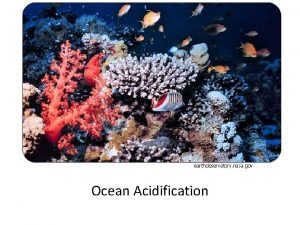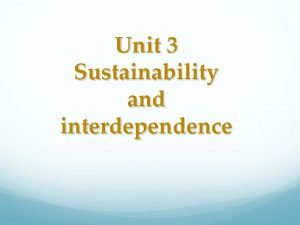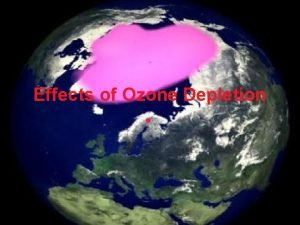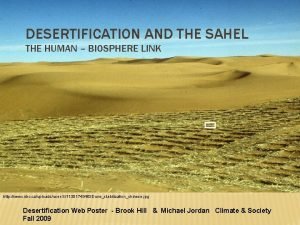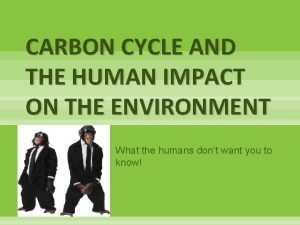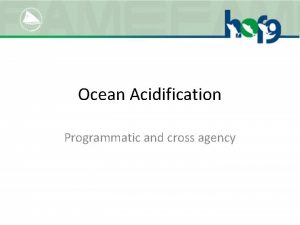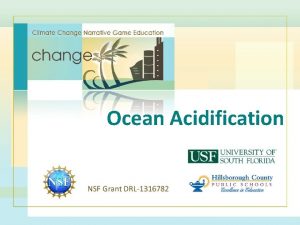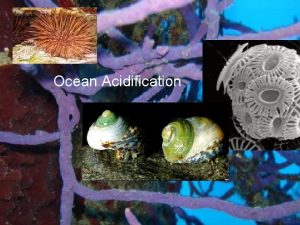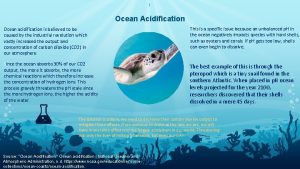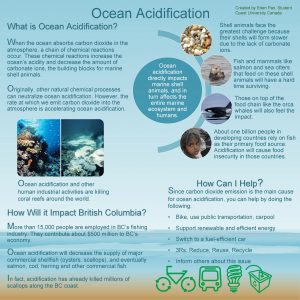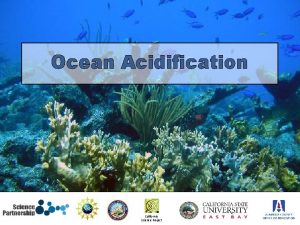Effects of Ocean Acidification Ocean Warming and Humans










- Slides: 10

Effects of Ocean Acidification, Ocean Warming, and Humans on Coral Reefs - IMPORTANCE OF REEFS - - CHALLENGES FOR CORAL REEF FUTURES - - Biodiversity, socioeconomic importance Ocean acidification/warming, additional factors KEY STAKEHOLDERS IN AUSTRALIA, AMERICA, AND CARIBBEAN - Scientific organizations - National/local governments - Private companies - Local communities BY CHASE GARRISON

Defining Coral Reefs and Challenges • Coral reef and zooxanthellae symbiosis • zooxanthellae provides photosynthetic products (amino acids, sugar, etc. ); coral provides essential nutrients (ammonia and phosphate) (Hoegh-Guldberg, 1999) • 0. 6 o. C increase in temperature of ocean’s upper layers past 100 years (Hoegh-Guldberg & Bruno, 2010). • expected to increase 1– 2 o. C each century (Hoegh-Guldberg, 1999) • Zooxanthellae can be stressed by 1 -2 o. C change, causing disassociation and coral bleaching (Hoegh-Guldberg, 1999) • Oceans are more acidic, average decrease of 0. 1 p. H (lowest in past 420, 000 years) (Hoegh-Guldberg, et al. , 2007) • Coral reefs have limited environmental ranges (Guan et al. , 2015) • t: 21. 7 -29. 6 o. C; salinity: 28. 7 -40. 4 ppt; N and P: 4. 51μmol/L and 0. 63 μmol/L; aragonite saturation: 2. 82 • Six major mass bleaching events have occurred since 1979, causing massive coral death, including entire reef ecosystems (Hoegh-Guldberg, 1999) • 50 to 70% of global coral reefs are directly threatened by human activities (Hoegh-Guldberg, 1999)

Coral Reef Hazards • Ocean Warming • increase in sea temperature (1 -2 o. C) and coral bleaching (Hoegh-Guldberg, 1999) • Ocean Acidification • p. H decreases (carbonate ion (CO 3 -) decreases); leads to lower production rates. (Pandolfi et al. , 2011). • Overexploitation of Fish/Shellfish • Reducing fish populations → increase in sea urchins that feed on zooxanthellae → reduced zooxanthellae → less coral reef (Sebens, 1994). • Reducing fish population → increase in benthic algae → reducing reef’s ability to recover from destruction after bleaching/storm events (Sebens, 1994). • Pollution/Eutrophication from Land Use Changes (Sedimentation, Pollution, Run Off) • Increased nutrient levels may benefit reef growth at first, but also benefits harmful macroalgae (Sebens, 1994). • Likely cause of outbreaks in crown-of-thorns (COTS) starfish Acanthaster planci that feeds on coral; responsible for 0. 53% decrease in coral cover per year (De’ath et al. , 2012).

Vulnerabilities of Coral Reefs • Rates of ocean acidification/warming are occurring too quickly for geochemical feedbacks to occur fast enough for reefs to adapt (Pandolfi et al. , 2011) • Smaller branching, thin-tissue acroporid and pocilloporid species are more susceptible to increasing temperatures than larger coral species (Walther et al. , 2002) • Reefs are limited in ability to move (Walther et al. , 2002) • Warmer oceans can lead to increased coral disease (Hoegh-Guldburg, 1999) • Threats of invasive species (Green et al. , 2012) • Limited environmental ranges (Guan et al. , 2015): • • t: 21. 7 -29. 6 o. C Salinity: 28. 7 -40. 4 ppt N and P: 4. 51μmol/L and 0. 63 μmol/L Aragonite Saturation: 2. 82

Foresight : Three Scenarios Three scenarios based on future CO 2 emissions (Donner, 2009): • • • Business-as-usual: CO 2 concentrations reach 700 ppm, 1. 9 -2. 4 o. C increase in SST by 2100; 80% of reefs experience mass bleaching at least once every five years by 2020 Mitigation: CO 2 stabilize at 550 ppm, 1. 1 -1. 5 o. C increase in SST by 2100; 80% of reefs experience mass bleaching once every five years by 2030 Commit: CO 2 concentrations at current levels (390 ppm), SST increase 0. 4 -0. 6 o. C by 2100; 80% of reefs experience mass bleaching once every five years by 2095 New evidences suggests many climate models do not accurately consider reef ability to cope/adapt to stress (Pandolfi et al, 2011)

Foresight : Three Scenarios Ecological/Socioeconomic effects of ocean warming/acidification: • • • Mass bleaching causes decrease in coral species, increases in macroalgae (Pandolfi et al. , 2011) Changes in inhabiting species due to bleaching/geographic changes (Pandolfi et al. , 2011; Walther et al. , 2002) Loss of 58% of global reef, estimated loss of $140 billion to lost tourism alone (Hoegh-Guldberg, 1999) Millions of fisherman depend on coral reef fisheries for employment (Hoegh-Guldberg, 1999) Marine tourism and commercial fishing employs 54, 000 people in Australia (Australian Government: Great Barrier Reef, 2018) • In Asia alone, coral reef fishes account for 1/4 of annual caught fish; feed 1 billion people (Hoegh-Guldberg et al, 2007)

Decision Making & Coral Reefs • Global • International Coral Reef Initiative and Coral Reef Alliance • Australia (Great Barrier Reef) • Australian Government • Great Barrier Reef Marine Park Authority • Queensland Government • Private companies, local communities • American Reefs • National Oceanic and Atmospheric Administration • Coral Reef Task Force - Coral Reef Conservation Act of 2000 • Coral Reef Conservation Program - works with scientific organizations, local/state governments, private companies, and local communities • Coral Reef Early Warning System (CREWS) • Caribbean Reefs • Caribbean Challenge Initiative - Governments and private companies from 8 island countries: Bahamas, Dominican Republic, Jamaica, Saint Vincent and Grenadines, Saint Lucia, Grenada, Antigua and Barbuda, Saint Kitts and Nevis. • Caribbean Diversity Fund

Options to Protect Coral Reefs • Regarding CO 2 emissions (Donner, 2009): • Business-as-usual (no action) – 700 ppm, 1. 9 -2. 4 o. C SST increase by 2100; 80% every 5 years by 2020 • Mitigation (reduce emissions) – 550 ppm, 1. 1 -1. 5 o. C SST increase by 2100; 80% mass bleaching every 5 years by 2030 • Commit (stop emissions)- 390 ppm, 0. 4 -0. 6 o. C SST increase by 2100, 80% every 5 years by 2095 • United Nations Sustainability Development Goal 14 (United Nations, 2016) • Significantly reduce all marine pollution by 2025 • Minimize and address ocean acidification impacts through scientific cooperation • End illegal, unreported, unregulated, and overfishing and implement management plans to provide maximum sustainability of fish populations by 2020 • Conserve at least 10% of coastal and marine areas by 2020 • Increase knowledge, develop research capacity and transfer of marine technology to improve ocean health and understanding of climate change effects

Recommendations • Mitigation scenario seems best/most likely; however, this scenario projects frequent mass bleaching events to occur by 2030. • Therefore, stricter limits to CO 2 emissions than mitigation scenario calls for so atmospheric CO 2 can remain under projected 550 ppm by 2100. • Reaching UN Sustainability Development Goal 14: • Reduce marine pollution • Implement responsible land use practices, limit agricultural pesticides/herbicides use • Address/minimize ocean acidification impacts • Significantly decrease greenhouse gas emissions • End unsustainable, illegal, and unreported/unregulated fishing practices • Strict commercial fishing regulations to maintain sustainable fisheries and require reporting of all fishing activity • Conservation of at least 10% of marine/coastal areas • Establish more marine protected areas and expand existing areas where coral reefs are found or could potentially grow • Increasing knowledge, research capacity, and transfer of marine technology • Introduce monitoring system such as NOAA’s CREWS in other reef areas • Increased funding of research and improve sharing of knowledge/information access

References De’ath, G. , Fabricius, K. E. , Sweatman, H. , Puotinen, M. , 2012. The 27 -year Decline of Coral Cover on the Great Barrier Reef and Its Causes. P Natl Acad Sci USA, 109, 17995 - 17999. Donner, S. D. , 2009. Coping with Commitment: Projected Thermal Stress on Coral Reefs under Different Future Scenarios. PLo. S One. doi: 10. 1371/journal. pone. 0005712 Green, S. J. , Akins, J. L. , Maljković, A. , Côté, I. M. , 2012. Invasive Lionfish Drive Atlantic Coral Reef Fish Declines. PLo. S One. doi: 10. 1371/journal. pone. 0032596 Guan Y. , Hohn S. , Merico A. , 2015. Suitable Environmental Ranges for Potential Coral Reef Habitats in the Tropical Ocean. PLo. S ONE, 10, 1 -17. doi: 10. 1371/journal. pone. 0128831 Hoegh-Guldberg, O. , 1999. Climate Change, Coral Bleaching and the Future of the World’s Coral Reefs. Mar Freshwater Res, 50, 839 -866. doi: 10. 1071/MF 99078. Hoegh-Guldberg, O. and Bruno, J. F. , 2010. The Impact of Climate Change on the World's Marine Ecosystems. Science, 328, 1523 -1528. Hoegh-Guldberg, O. , Mumby, P. J. , Hooten, A. J. , Steneck, R. S. , Greenfield, P. , Gomez, E. , Harvell, C. D. , Sale, P. F. , Edwards, A. J. , Caldeira, K. , Knowlton, N. , Eakin, C. M. , Iglesias-Prieto, R. , Muthiga, N. , Bradury, R. H. , Dubi, A. , Hatziolos, M. E. , 2007. Coral Reefs Under Rapid Climate Change and Ocean Acidification. Science, 318, 1737 -1742. Pandolfi, J. M. , Connolly, S. R. , Marshall, D. J. , Cohen, A. L. , 2011. Projecting Coral Reef Futures Under Global Warming and Ocean Acidification. Science, 333, 418422. doi: 10. 1126/science. 1204794. Sebens, K. P. , 1994. Biodiversity of coral reefs: what are we losing and why? Amer Zoo, 34, 115 -133. United Nations, 2016. Goal 14: Conserve and sustainably use the oceans, seas and marine resources. https: //www. un. org/sustainabledevelopment/oceans/. Accessed on April 13, 2018.
 Ocean acidification
Ocean acidification Ocean acidification
Ocean acidification Inbreeding in humans
Inbreeding in humans Ozone depletion effects on humans
Ozone depletion effects on humans Desertification effects on humans
Desertification effects on humans Effects of carbon monoxide on humans
Effects of carbon monoxide on humans Desertification effects on humans
Desertification effects on humans Chapter 15 ocean water and ocean life
Chapter 15 ocean water and ocean life Divergent vs convergent plates
Divergent vs convergent plates Ocean ocean convergent boundary
Ocean ocean convergent boundary Ocean to ocean convergent boundary
Ocean to ocean convergent boundary

